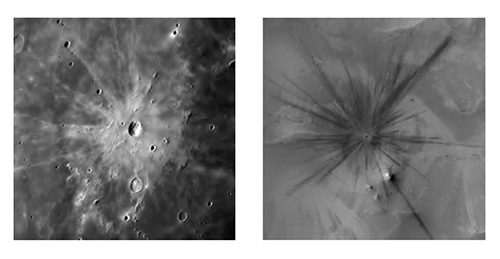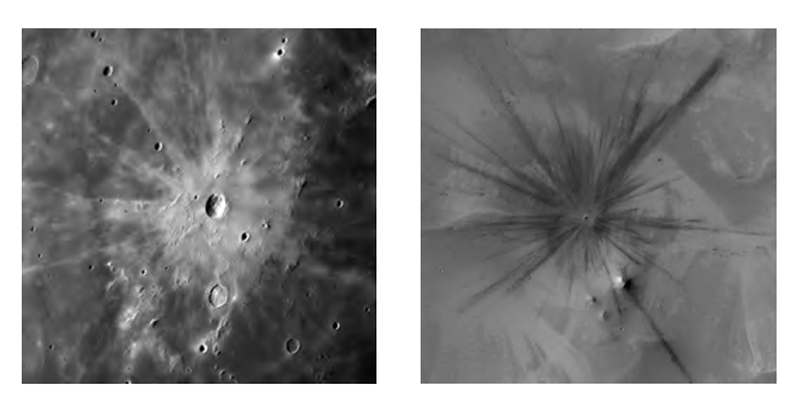Surface Texture is Key to Rays Forming Around Craters
Anyone who has observed the Moon through binoculars or a telescope has seen the striking craters that cover its surface. The careful eye may even have noticed that some of these craters are surrounded by lighter-colored radial streaks of material, or “rays,” that can extend a distance several times the crater diameter (Fig. 1). Such rays are made when a high-speed meteorite impacts the Moon and ejects material from its surface [1, 2], but why this ejecta lands in a pattern of rays instead of a smooth ring around the crater is a mystery. Now a simple explanation has been put forth by researchers who studied craters that form when a steel ball is dropped into a container of tiny glass beads [3]. Tapan Sabuwala and co-workers at the Okinawa Institute of Science and Technology Graduate University, Japan, observed that rays appeared only when the surface of the bed of beads was textured, as opposed to flat. The team’s study also suggests that features of the ray pattern could be used to understand properties of the impacting object and the preimpact surface.
Live viewings of large-scale astrophysical impacts are hard to come by—a notable exception being a meteorite that hit Peru in 2007 [4]. Instead, most of our knowledge about craters on the Moon and planets comes from postimpact studies of either geological samples or data collected via telescope and remote sensing. From these observations, many of which began during the Apollo era, we know that rays stand out against the background rock because they have a different composition and/or have had less exposure to microimpacts and other forms of space “weathering” [5].
Researchers can also simulate the cratering process with computer models and analog experiments. So-called “hypervelocity” impact experiments entail firing a pea-sized projectile into a target at speeds exceeding the speed of sound in the target. A complementary approach, and the one Sabuwala et al. use, involves much lower-velocity impacts. Here, an object falls under gravity into a container of sand or beads [6, 7]. Like any analog experiment, these two methods capture some, but not all, of the real thing. Hypervelocity models reflect the speeds of actual planetary impacts, but they are much smaller in scale. Low-velocity impact experiments involve many orders of magnitude smaller impact energies, and the projectile is not destroyed by the impact. Moreover, most of the energy in a granular impact is dissipated by friction, while the energy of a planetary impact primarily goes into excavating the crater. Despite these differences, the flow in a granular material following an impact is much the same as the flow of the surface material on the Moon or a planet after a meteorite hits. The morphology of the granular craters is also similar to that of their planetary counterparts [6, 7].
No analog experiments have yet been able to reproduce ray patterns in the lab. Sabuwala and co-workers, however, found evidence for rays in an unexpected place: science outreach programs often demonstrate crater formation by dropping a marble into a container of flour, and the researchers noted that photos of such demos often show hints of rays around the craters in the flour [8]. They also recognized that a significant difference between the “professional” experiments and those done by enthusiastic amateurs was that the professionals were too careful—they smoothed the surface of their target prior to dropping the object. Intrigued by the idea that surface roughness might be a key ingredient, Sabuwala and colleagues imprinted an otherwise flat bed of beads with a hexagonal grid. Sure enough, they observed rays of ejected material when they dropped a steel ball on the textured surfaces (Video 1), but saw only a smooth ejecta layer for balls dropped on flat surfaces (Video 2). They also determined that the number of rays is proportional to the ratio of the ball’s diameter D to the spacing 𝜆 between the centers of the grid hexagons.
Sabuwala et al. obtained a more detailed picture of ray formation by carrying out simulations that modeled the behavior of many individual interacting grains in granular impacts. As in the experiments, they found that rays form only when an object impacts a textured surface. The simulations also allowed them to trace the paths of the particles backward in time, from which they could see that the grains in the rays originate from grid impressions, or “valleys,” located in a narrow annulus around the edge of the impacting ball. Furthermore, they found that the number of rays equals the number of valleys that are overlapped by the edge of the ball.
The researchers offer a straightforward explanation for their findings. An impact produces a shockwave in the target material that travels outward and upward. When it reaches the surface, this wave is reflected downwards, causing grains to be ejected with a component of their velocity normal to the surface. If the surface is smooth, this normal component will be axisymmetric, and the ejecta will form a smooth ring around the crater. A bumpy surface, by contrast, will break this axial symmetry and tend to focus the ejecta into rays.
If this focusing mechanism explains ray formation on the Moon and on planets, then ray patterns may provide useful information for planetary scientists. For example, the ray patterns can be viewed as an “echo” of the topography of the surface on which an object landed. Moreover, the size of the impacting object can be estimated from the number of rays, along with additional information on the topography. To illustrate this idea, the team examined the 32-km-wide Kepler crater on the Moon. Based on the number of prominent valleys in the nearby terrain and the fact that the crater has eight prominent rays, the researchers determined that Kepler was formed by the impact of an object 3.4 km in diameter, in very reasonable agreement with existing estimates. Although this success is preliminary, it suggests that researchers are on the right track toward finding a new method of analyzing planetary craters.
This research is published in Physical Review Letters.
References
- E. M. Shoemaker, “Interpretation of Lunar Craters,” in Physics and Astronomy of the Moon, edited by Z. Kopal (Academic, New York, 1962), p. 283[Amazon][WorldCat].
- H. J. Melosh, Impact Cratering: A Geologic Process (Oxford University Press, New York, 1989)[Amazon][WorldCat].
- T. Sabuwala, C. Butcher, G. Gioia, and P. Chakraborty, “Ray Systems in Granular Cratering,” Phys. Rev. Lett. 120, 264501 (2018).
- G. Tancredi et al., “A Meteorite Crater on Earth Formed on September 15, 2007: The Carancas Hypervelocity Impact,” Meteorit. Planet. Sci. 44, 1967 (2009).
- B. Ray Hawke, D. T. Blewett, P. G. Lucey, G. A. Smith, J. F. Bell, B. A. Campbell, and M. S. Robinson, “The Origin of Lunar Crater Rays,” Icarus 170, 1 (2004).
- J. C. Ruiz-Suárez, “Penetration of Projectiles into Granular Targets,” Rep. Prog. Phys. 76, 066601 (2013).
- A. M. Walsh, K. E. Holloway, P. Habdas, and J. R. de Bruyn, “Morphology and Scaling of Impact Craters in Granular Media,” Phys. Rev. Lett. 91, 104301 (2003).
- For an example, see http://cpsx.uwo.ca/outreach/student_programs/index.html.





